The “Diesel gate” scandal created a mighty havoc in the automotive industry due to emission regulation violation with a defeat device. World Harmonised Light Vehicle Testing Procedure (WLTP) and Real Driving Emissions (RDE) procedures have been proposed in early 2008 and have been sitting on the regulators table. The emission scandal gave an impactful push to changes in vehicle testing procedures from being an idea to reality. In September 2016, The United Nations Economic Commission for Europe (UNECE) and World forum for harmonisation of vehicle regulations (WP29) formulated the WLTP that simulates the real world conditions with various parameters such as higher engine load, variable temperature, high acceleration, and fewer stopping phases. OEMs such as BMW, Daimler, PSA, Renault Nissan, VW, and GM were playing a vital role to finalise the testing parameters. Post the WLTP forum meet all OEMs will receive the final proposal of the WLTP testing and date of implementation. Since the eruption of Diesel Gate scandal, RDE were given higher priority than WLTP. Various engine technologies such rightsizing/downsizing, high-speed transmission system and light weighting along with advanced after-treatment technologies such as selective catalytic reduction (SCR), lean NOx traps (LNT), exhaust gas recirculation (EGR), diesel particulate filters (DPF), and gasoline particulate filters (GPF) were given higher priority to comply to the stringent regulation. The global automotive market is currently adopting new testing procedures. What will be the role of advanced powertrain technologies among key OEMs? What will be the impact of these advanced technologies in RDE and WLTP?
Figure 1: Vehicle Testing Procedure Market: Test Procedure Classification, Global, 2016
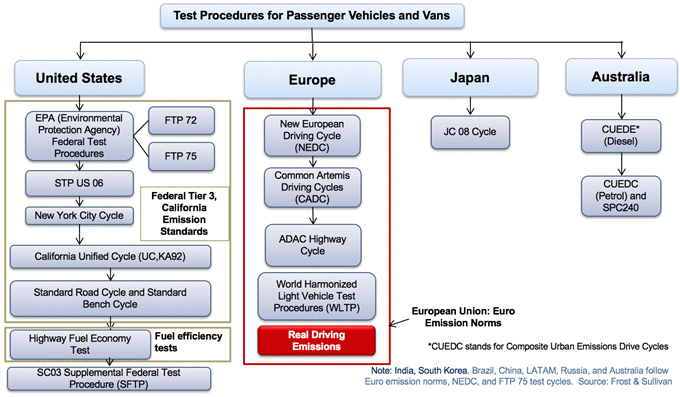
Real Driving Emissions Testing and Its Implementation
As OEMs are expected to comply with the Euro 6 emission parameters, RDE ensures that the on-road Euro 6 diesels deliver the rated emission levels (such as CO2 and NOx targets). The testing is carried out by using a portable emissions monitoring system (PEMS) to measure the real-time values of NOx emissions. The Euro 6 legislation was passed in 2007 and all OEMs are expected to comply with the norms from 2015. Though the legislation (80 mg/km of NOx for diesel engines) was passed, vehicles on road have failed to emit within limits in real driving conditions. Hence, the PEMS and RDE testing methods will help the European Union Commission and the Member of states monitor the emission levels by introducing an “Conformity factor” (CF) (figure 2) for setting the permitted limits from 2017 to 2021. The phase-in is planned from September 2017 that all vehicles sold have to be tested by an external technical service provider to certify the vehicle. New European Driving Cycle (NEDC) and RDE rating on the vehicle certificate will ensure that emission ratings are as per the authorization of TCMV and EU commission. During the first period from September 2017, new models should comply with a conformity factor of 2.1 (110 percent more than permissible limit exceeding the NOx limit of 80 mg/km). The main objective is to give OEMs time to gradually adapt to the new RDE rules and the first conformity factor for all OEMs will phase out in 2021 after the ACEA target of 95 g/km CO2 is achieved (figure 3). During the second stage of RDE, from January 2020 for new models and from January 2021 for new vehicles, the conformity factor will be only 1 plus the margin error, which is currently set at 0.5 (overall with 1.5 conformity factor the NOx limit should exceed only by 50 percent). The second conformity factor will be annually reviewed and monitored by the Commission with technical improvements in testing equipment.
Figure 2: Vehicle Testing Procedure Market: Conformity Factor for RDE, Europe, 2016
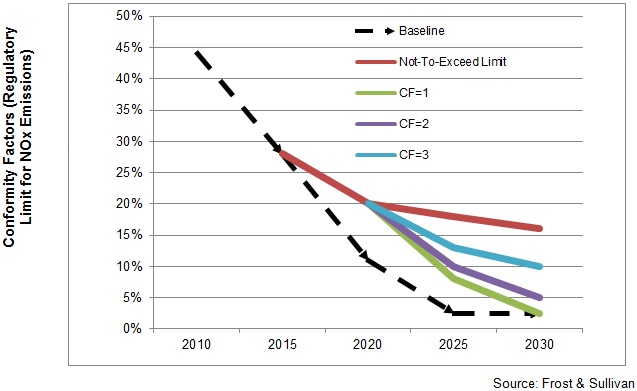
The European Commission and UNECE will focus to have a steady shift from NEDC to RDE & WLTP to regularize and monitor emission levels and fuel economy. Initial focus will be to enforce technical centers to carry out the real driving emission testing across all OEMs. NEDC testing will be used across all OEMs until 2020, but will require the RDE and NEDC certification to be carried out by technical service providers (figure 3). During this process, the European commission will enforce the shift to only RDE and WLTP from 2021. The time period 2017-2020 will be the transition phase where OEMs will focus to reduce their fleet average emissions to 95g/kms CO2 with NEDC testing procedure, but will look to optimise their technology to RDE/WLTP. The automakers are currently in a difficult position as the RDE implementation is far more rigorous than that of WLTP, but with the flexible limit of the conformity factor will help OEMs achieve NOx limits across their vehicle portfolio. From September 1, 2017, RDE tests carried out technical centers will determine whether the new vehicle model has to be released in the market. Approximately by the end of 2018, the certificate of conformity factor will be issued to the consumer by the manufacturer in a way to show full transparency of the real emissions performance. The Commission will define the rules for independent RDE testing of vehicles being in service, including the regulatory consequences in case of non-compliance.
Figure 3: Vehicle Testing Procedure Market: Timeline for Implementation of the WLTP/RDE, Europe, 2016
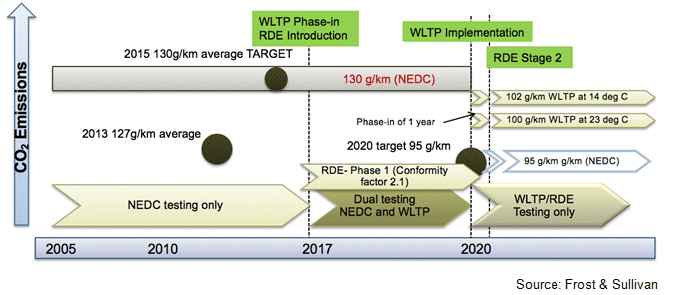
Figure 4: Vehicle Testing Procedure Market: Roadmap of RDE Implementation, Europe, 2015-2021
RDE Certification and Test Cell
According to the table, every OEM is subjected to carry out on road and dyno testing with various simulations of WLTP and NEDC. RDE will be carried out with the help of PEMS by technical service providers such as Ricardo, AVL, FEV, and Delphi. OEMs will be affiliated with technical service providers who monitor, record, and document data from the testing and will be shown to the European Commission. The series of simulations, dyno testing, test bed validation, and on-road testing for all models will ensure the EU emissions certificate. RDE testing will point out the key risk factors (failure in injection timing, engine temperatures, exhaust after treatment efficiency, scavenging, and so on). Thus, improper combustion will lead to higher NOx or CO2 reading that will be tested in the RDE cycle.
Figure 5: Vehicle Testing Procedure Market: RDE Certification Process, Europe, 2017
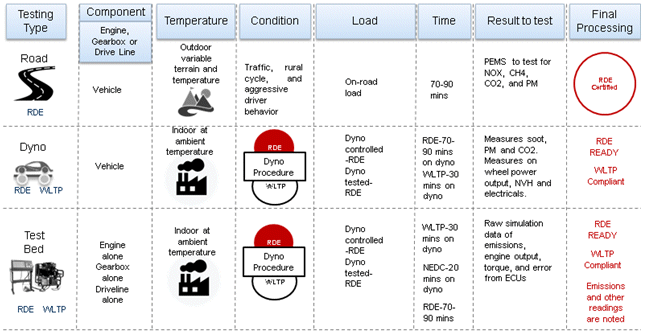
Impact of Real Driving Emissions
As a result of the Dieselgate scandal, there is a decrease in diesel adoption, but the possibility of the phasing out of diesel will not happen as the RDE testing will play a vital role to keep conventional engines within emission limits. RDE will impact the current powertrain and hybrid technologies, as the new optimising techniques need to be incorporated to achieve the existing emission and performance results. Engines have to be optimized with a wide engine map area for emissions, but rich combustion leads to scavenging of turbo chargers. Diesel engines will require higher adoption of exhaust after treatment systems to accommodate high exhaust flow under “normal condition of use” and cooling down of the exhaust system due to fuel shut off during deceleration will affect the performance and conversion efficiency of the exhaust system. The adoption of lean NOx traps (LNT) will be inefficient in RDE cycle as the efficiency will be low at higher rpms/higher acceleration. Gasoline engines have to be optimized along with gasoline particulate filter (GPF) due to the Euro 6C PN limit reduction (PN limit-10 nm PN instead of 28 nm). Optimisation of electric and hybrid powertrain systems will be affected as the RDE/WLTP has rapid acceleration and deceleration that will affect the battery power and constant power output will vary. Overall, adoption of new technologies will impact the price of the vehicle. Adopting a new test cycle will cause higher testing time and cost to all OEMs.
RDE testing for gasoline engines:
- Focus on minimized CO2, NOx, and PN emissions at high load operation and low temperature points
- RDE-compliant gasoline engine design and combustion systems will be developed for best emission robustness with a focus on maximized lambda=1
- Emission calibration optimization with a focus on dynamic and non-standard ambient conditions
- Downsizing, turbocharging, and scavenging has to be optimized to suit the RDE cycle
- GPF/3 way catalyst integration for GDi including soot loading model and regeneration/OBD strategy
RDE testing for diesel engines:
- At higher load operating range of the engine, the reduction of NOX emission will be lower as there is a negative effects to PMs and fuel consumption
- Exhaust after treatment calibration for all types of systems (for example, DOC, LNT, SCR, DPF, and SCR on DPF)
- SCR/LNT will help compliance with RDE and WLTP, as NOx and CO2 will be reduced by 98 percent and 100 percent respectively
- DPF development together with temperature management and soot loading model
- Therefore, the use of SCR will be mandatory all diesel engine in Europe to comfortably comply RDE/WLTP
Figure 6: Vehicle Testing Procedure Market: RDE Impact, Europe, 2016
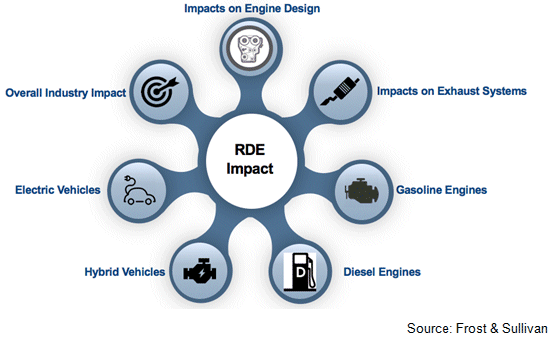
Final Verdict
OEMs will have their production and development costs impacted by increasing the overall value proposition in a vehicle on powertrain/infotainment areas. Adopting WLTP will influence sustainable emission-less mobility. Standardizing test procedures will decrease testing costs, as OEMs can share test beds. UNECE and ACEA will enforce the reduction of fleet emissions average and then make the transition from using NEDC to WLTP. The use of advanced technologies by key leading OEMs will support the adoption of new test cycles and will help OEMs to portray consistent performance and efficiency. Downsizing, multiple boosting systems, and hybrid technologies will help in RDE testing. Most importantly, exhaust after-treatment systems will play a vital role as NOx and CO2 reduction will be quite efficient with 95-98 percent (NOx reduction) and 100 percent CO2 reduction. SCR/LNT will play an intensive role for engines to qualify RDE testing as SCR NOx reduction will be the most efficient system. SCR will be mandatory for all Euro 6 engines with 2L and above capacity from 2017 to effectively comply with regulations.



